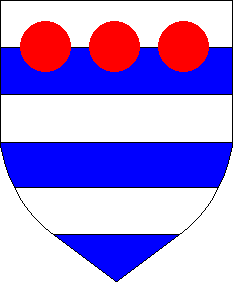 to Bios Page
to Bios Page to Family Page
to Family Page
 to Peerage Page
to Peerage Page to Home Page
to Home PageSir Thomas GREY of Horton, Knight
Born: ABT 1509, Horton, Northumberland, England
Died: 5 Aug 1570, Bethal Green, Middlesex, England
Father: Roger GREY of Horton (Sir Knight)Mother: Isabel DARCY
Married: Dorothy OGLE ABT 1530, Northumberland, EnglandChildren:
3. Isabel GREY
4. Margery GREY
5. Barbara GREY
6. Roger GREY
7. Ursula GREY
10. Dau. GREY
The details in this biography come from the
History of Parliament, a
biographical dictionary of Members of the House of Commons.
Born by 1515, first surviving son of Sir Roger Grey of
Horton by Isabel, daughter of Sir William Darcy.
Married 1527/1531, Dorothy, daughter of Ralph, 3rd Lord Ogle, widow of
Sir
Thomas Forster of Berwick-upon-Tweed, Northumberland. Succeeded father 6 Jan 1543. Knighted 23 Sep 1545.
Member of Parliament for Northumberland Oct 1553, Nov 1554, 1559. Yeoman? of the guard bef.
Dec 1531; Justice
of the Peace, Northumberland 1547-1554; treasurer, Berwick-upon-Tweed Jun
1547-Feb 1550; sheriff, Northumberland 1547-1548, 1551-1552, Nov or Dec 1558;
constable and receiver, Dunstanburgh Jun
1550, steward May 1555-death; commissioner goods of churches and fraternaties,
Northumberland 1553. The first certain reference found to him is
his appointment in 1536 as deputy to his maternal uncle
Thomas Lord Darcy,
keeper of Bamburgh Castle, which lies within ten miles of Horton. After
Darcy's
execution in the following year Grey
petitioned Cromwell for the keepership: he was passed over, but one of the lists
recording the new appointment bears a note 'to remember Thomas Grey', and in the
same year he was appointed one of the officers of the east march at a salary of
20
pounds per year. His career might have come to an abrupt end when in May 1538 he
and his uncle Lionel, porter of Berwick, were arrested on
Cromwell's orders by
the captain of Berwick, Sir Thomas Clifford.
Cromwell evidently dismissed
the charges as groundless. ABT the same time Thomas Grey was one of those appointed to bring ten men to help put down a
threatened revolt by the men of Tynedale. In the Scottish campaign of 1542
Grey
commanded 100 men and in the following winter he had charge of the night watch
at Horton. He took part both in the burning of Jedburgh in Jun 1544 and in the
defeat of the simultaneous Scottish raid into
Northumberland. The relationship thus established with
Edward Seymour, Earl of Hertford, who commanded in the north, was to serve
Grey well during the next
few years. It was from Hertford that he received his knighthood at Norham in Sep
1545, on his return from another foray into Scotland, and
Hertford's assumption
of the Protectorate in 1547 was followed by Grey's appointment as treasurer of
Berwick and paymaster of the pensioners in the marches. The fall of the
Protector cost Grey the
treasurership of Berwick, which went to Richard Bunny, but this was partially
offset in Jun 1550 by a grant of the constableship of Dunstanburgh, a coastal fortress south of Bamburgh, and of a 21-year
lease of the site and possessions of the monastery of Newminster,
Northumberland: the property, which included coal-bearing land, was leased to
Grey in consideration of services 'previously rendered'. His own interest in the
consolidation of
the family's possessions was reflected in the settlement of his lands, after his
only son had died in infancy, on whichever of his daughters should marry his
kinsman Sir Ralph Grey of Wark and Chillingham: it was his eldest daughter
Isabel who
did so. In Apr 1554 the Council exhorted him and
other Northumbrian gentlemen 'to show themselves more forward in service than
they have erst done whereby they shall well redub (repair) their former
slackness', and in Sep 1556 and Aug 1557 he
was summonded before the Council: on the last occasion, having professed himself
'very willing to serve' Queen
Mary, he was commissioned to carry a 'mass of treasure' to the north, where he
offered to serve against the Scots without pay. He had, on the other hand, won
the regard of both John Conyers, 3rd Baron Conyers, and
Thomas Wharton, 1st Baron Wharton, who intervened on his behalf when he
was called before the council in the north in 1554 and 1556. Although Strype was
to describe Grey as 'one of the best reputation in the parts adjoining Scotland'
it is doubtful whether he diverged markedly for the Catholicism of his
neighbors:
when he and Cuthbert Horsley were returned to Parliament in Oct 1554 the
sheriff described them on the indenture as 'two of the grave and Catholic
persons (within) the said county', and Grey'S associates and kinsman were noted
for their
religious conservatism. He died at Bethal Green, Middlesex, on 5 Aug 1570.
 to Bios Page
to Bios Page |
 to Family Page
to Family Page
|
 to Peerage Page
to Peerage Page |
 to Home Page
to Home Page |